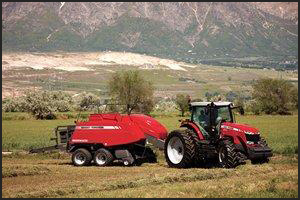 Baling Tips
Baling Tips
for Superior
Hay Quality
Whether you choose large round, large square or small square bales, making high-quality bales that preserve hay quality, maximize protection from the weather, and are easy to store or transport boils down to following a few rules.
The first, and most basic rule, is simplest of all: “Get out of the tractor, and check your baler and the first bales from a field to make sure adjustments are right so the density and shape of the bales are correct,” says Dean Morrell, Agco product marketing manager for Hesston by Massey Ferguson® hay products.
“The biggest mistake people make is moving too fast when they start baling. They don’t get out of the tractor to verify that everything is right, and if it is not, to tweak adjustments until it is,” he says. “The same rule applies to cutting, conditioning and raking. It’s a missed opportunity if you don’t get out of the tractor cab.”
Adjusting a baler to produce high-quality bales is relatively straightforward, says Morrell. Of course, by starting with windrows that are uniform in width and in the amount of hay they contain, producers help ensure bales are consistent in shape and density. Also, windrows that are as large as possible to meet the baler capacity help minimize the amount of loss during the baling process when hay is at its driest and most subject to leaf loss from handling.
Operating manuals provide a full rundown on how to set balers to make dense bales that are consistent in size and shape. Here are Morrell’s quick tips for doing the job right:
- Set baler pickup tines about 1 inch (in.) above the ground. This helps prevent contaminating the hay with dirt, which raises ash percentages and reduces digestibility. Baler wear and tear caused by picking up stones also is reduced or eliminated.
- Set the hay pickup flotation so the pickup follows the contour of the ground at or just above the tine height setting. If the tines aren’t digging into the dirt, the flotation setting is about right. Regularly check the hay pickup for bent or broken tines and replace them as necessary. Be sure to stock up on replacement parts before the hay season begins.
- Synchronize the field speed and the baler pickup speed so the hay is lifted from the windrow and flows into the bale chamber. Pickup loss is lower when windrows are heavy because the baler is operated at a slower field speed and there is less contact between the hay and the baler components.
- Bale chamber loss, particularly of the valuable leaves, is typically two to three times greater in round balers compared to square balers. To minimize bale chamber losses in round balers, the feed rate should be as high as possible to minimize the number of turns the hay makes within the bale chamber. This can be accomplished by using large windrows and high forward speeds. Since pickup losses are normally lower than chamber losses, it’s usually better to have some pickup loss by driving faster but reducing the amount of time it takes to form the bale.
- Monitor bale density. Even if your baler has a density gauge, it is still critical to get out of the cab and “thump” bales to verify that the density is high enough so that bales hold their shape and provide maximum protection from the elements. “You really don’t want to be able to stick your fingers into the bale,” Morrell says. “If you kick the bale, it should hurt your foot.”
- Follow drive directional arrows on the baler monitor to make sure hay is fed consistently across the width of the bale chamber so bales have square shoulders. This helps round bales shed moisture, and improves stacking attributes of square bales.
- Hay moisture at baling is a critical factor in determining superior hay quality and long storage life. Assessing moisture before baling depends on whether it is stem moisture or moisture from dew. The moisture present from dew will seep through the hay to some degree, while stem moisture will not. When the stem moisture is too high, spoilage can occur. Moisture at baling for large square bales should be no greater than 12%-15%; for round bales, no greater than 16%-20%; and no greater than 18%-20% for small square bales. The exception to this rule is when hay preservative is applied during baling, which allows hay to be baled with moisture content up to 30%.
- To reduce leaf shatter and resulting nutrient losses, avoid baling when hay moisture is too low.
- Make sure all operators know how to adjust the baler for top quality.
- Keep up to date on regular maintenance to ensure peak machine performance. Be sure to visit your local dealer to stock up on pickup tines, common bearings, chain repairs, belts, shear bolts and other common repairs before the hay season starts to minimize downtime from common breakdowns. Dealers often have a list of recommended parts for on-farm stocking and may offer preseason discounts for parts purchases.
Editor’s Note: This article was provided by AGCO.





